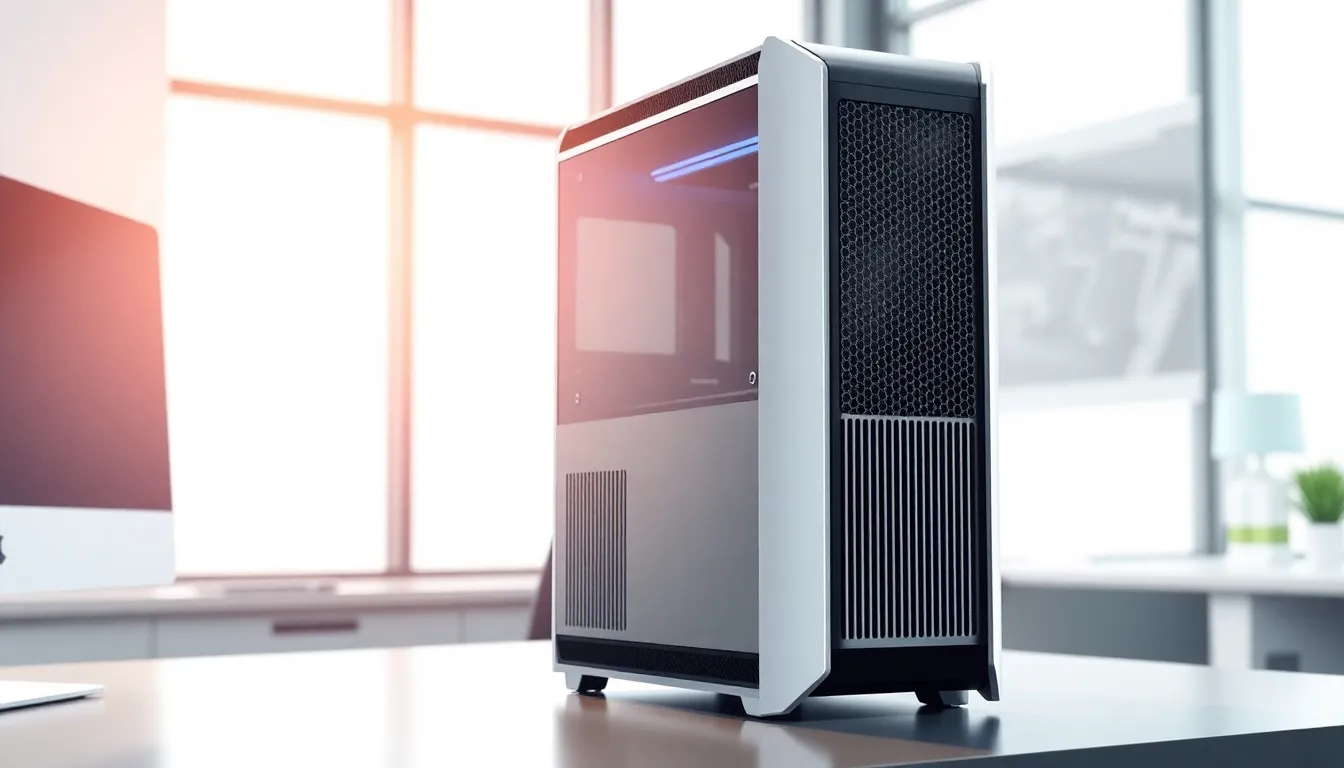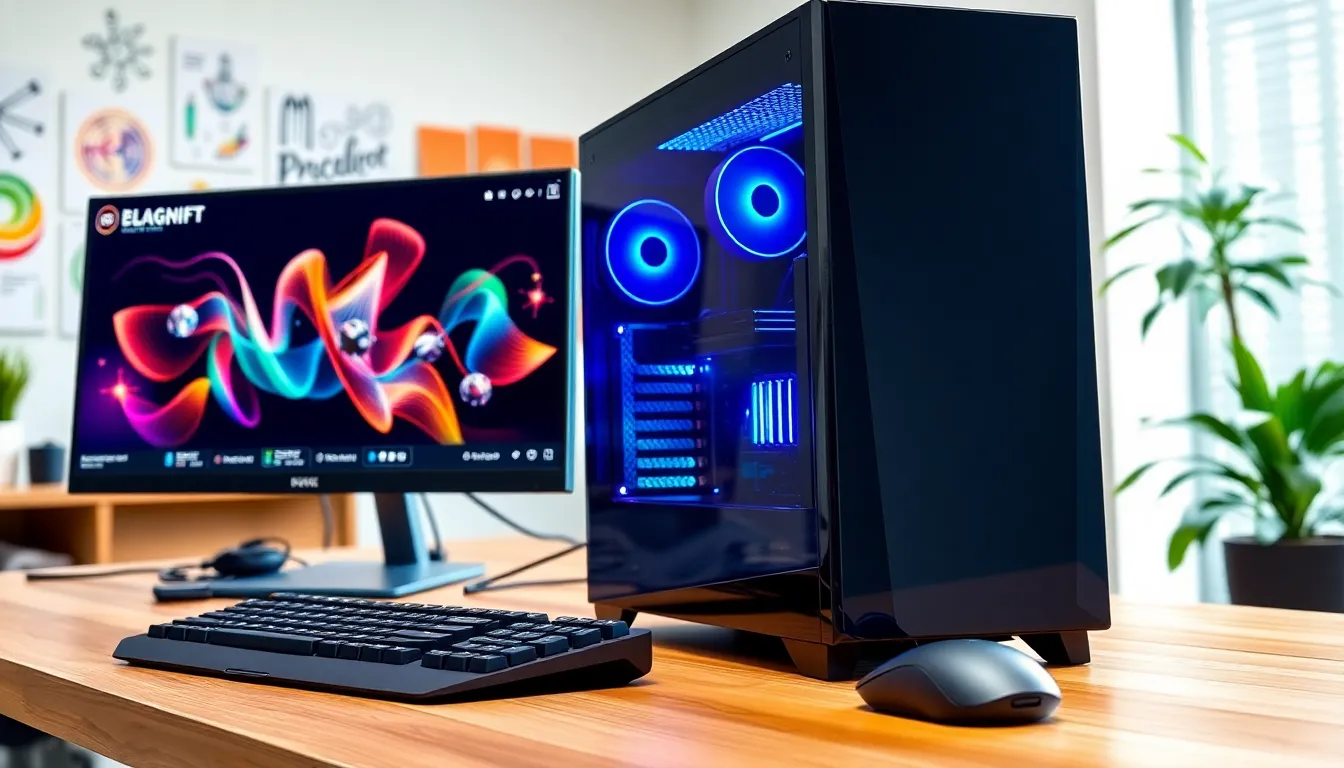In a world where sleek laptops and tablets steal the spotlight, desktop computer towers stand tall like the unsung heroes of the tech realm. These sturdy boxes may not fit in a backpack, but they pack a punch with power, performance, and upgradability. Think of them as the reliable workhorses that never complain, unlike that one coworker who always “forgets” to mute during a video call.
Table of Contents
ToggleOverview Of Desktop Computer Towers
Desktop computer towers represent a core element of personal computing. They offer superior processing power and performance compared to their portable counterparts. Users often find greater flexibility when upgrading components, ensuring their systems remain relevant as technology evolves.
Towers typically house multiple components, including the central processing unit (CPU), graphics processing unit (GPU), hard drive, and power supply. This arrangement allows for optimized cooling systems, enhancing overall performance. Efficiency in design helps minimize overheating, promoting longevity of the hardware.
Configurability serves as another strength of desktop towers. Users can select specific configurations to meet their individual needs, ranging from gaming to graphic design. Many models cater to various preferences, whether seeking high-end gaming rigs or simple office setups.
Connectivity options abound with desktop computer towers. They support a range of peripherals such as monitors, keyboards, and printers through multiple USB ports and audio jacks. Some models even include wireless connectivity options, such as Wi-Fi and Bluetooth, for added convenience.
Cost-efficiency plays a key role in the choice of a desktop tower. While initial costs may be higher, the long-term benefits, such as easy upgrades and repairs, prove worthwhile. A desktop’s ability to stay current with software advancements often surpasses that of laptops and tablets.
Durability also merits consideration. Desktop towers generally endure wear and tear better than smaller devices. Their robust construction contributes to longer lifespans, making them ideal for users seeking reliability.
Key Features Of Desktop Computer Towers

Desktop computer towers offer a range of features that enhance their performance and usability. These towers cater to various requirements, ensuring that users receive the optimal technology for their needs.
Form Factor
Form factors define the physical dimensions and layout of desktop towers. Standard configurations, such as Mini Tower, Mid Tower, and Full Tower, provide flexibility for different PC builds. Compact designs prioritize space-saving solutions while maintaining functionality. Additionally, larger towers typically support advanced hardware installations, ensuring ample room for upgrades. The choice of form factor influences airflow and thermal management, impacting overall system performance and longevity.
Power Supply
Power supplies play a crucial role in powering desktop computer towers. Efficient power supplies, rated by 80 Plus certification, ensure energy savings and stable performance. Varied wattage options allow users to match their power needs with the components selected. Quality power supplies feature modular designs to minimize cable clutter, simplifying upgrades and maintenance. Robust power management protects sensitive components and supports high-performance graphics cards and processors, making it essential for demanding tasks and gaming.
Cooling Systems
Cooling systems are essential for maintaining optimal operating temperatures within desktop towers. Air cooling, commonly found, uses fans to dissipate heat generated by internal components. Liquid cooling offers advanced performance through efficient heat transfer, suitable for overclocked systems. Effective cooling solutions help prolong hardware lifespan and enhance overall performance. Furthermore, well-designed airflow pathways within the tower case promote consistent cooling, ensuring that every component runs efficiently and reliably.
Popular Desktop Computer Towers Brands
Several brands stand out in the desktop computer tower market, known for their reliability, performance, and versatility.
Brand A
Dell offers a range of desktop computer towers that cater to both casual users and gamers. Their OptiPlex series targets business environments with efficient, compact designs that emphasize durability. XPS models provide high-performance configurations, often equipped with powerful GPUs and robust cooling systems, suitable for advanced tasks. Customers appreciate the customization options, allowing for tailored builds that match specific needs.
Brand B
HP stands as another key player in the desktop computer tower sector. Their Pavilion series focuses on providing solid performance for everyday tasks and entertainment. For professionals seeking high performance, HP’s Omen series delivers powerful gaming towers with advanced graphics options. HP emphasizes user-friendly designs and a commitment to energy efficiency, ensuring towers run smoothly without excessive power consumption.
Brand C
Lenovo is recognized for its innovative desktop computer towers, particularly within the ThinkCentre and Legion lines. ThinkCentre models appeal to business users with their emphasis on security and management features. In contrast, the Legion series targets gamers with high-performance specs and customizable RGB lighting. Lenovo’s commitment to sustainability also resonates with environmentally conscious consumers, further enhancing its brand reputation.
Advantages Of Using Desktop Computer Towers
Desktop computer towers provide several key benefits that make them a compelling choice for many users. They offer superior processing power compared to laptops or tablets, making them ideal for resource-intensive tasks like gaming and graphic design. Performance often surpasses portable devices due to the ability to house high-end components, ensuring users get the most out of their hardware investment.
Upgradability stands out as another significant advantage. Users can easily replace or add components such as graphics cards, memory, and storage, adapting their systems to evolving technology without needing to buy a completely new machine. Many find that this flexibility helps extend the life of the desktop, enhancing long-term value.
Cooling systems in desktop towers usually outperform those in smaller devices. Effective airflow and advanced cooling solutions, whether air or liquid, maintain optimal operating temperatures, which prolongs the lifespan of components. This advantage becomes crucial during demanding tasks, where heat buildup can impact performance.
Connectivity options also play a vital role. Desktop towers typically feature multiple ports and expansion slots, allowing users to connect various peripherals easily. Such versatility facilitates seamless use of additional monitors, printers, and other devices, improving overall productivity.
Cost efficiency emerges as a notable factor. While the initial investment might be higher, easy upgrades and repairs can lead to lower overall costs in the long run. Users benefit from reduced maintenance expenses, making desktop towers a financially smart option.
Durability of desktop computer towers contributes to their appeal. These systems often withstand wear and tear better than their portable counterparts. Longevity becomes a key consideration for users looking for a reliable computing solution that stands the test of time.
Disadvantages Of Desktop Computer Towers
Desktop computer towers come with certain drawbacks that may affect user choice. They typically occupy more space than laptops or all-in-one computers. This increased footprint can complicate setups in smaller workspaces or home offices.
Transportation doesn’t favor desktop towers; moving them from one location to another poses a significant challenge. Weighing more than portable devices, they are less convenient for users requiring mobility.
Noise levels can also be a concern. Fans and cooling systems often generate sounds that may distract users in quiet environments. While efficient, some cooling solutions can still create noticeable noise during operation.
Cost considerations arise when comparing initial investment versus portable options. Desktop computer towers may require a higher upfront payment, especially for high-performance configurations. This expense can deter budget-conscious consumers or those new to computing.
Once set up, space limitations restrict users from easily rearranging components or upgrading without significant effort. Some systems may also come with proprietary parts that limit compatibility, complicating upgrades further.
User familiarity plays a role; those accustomed to laptops may find desktop interfaces unfamiliar or less intuitive. Transitioning from portable devices can require an adjustment period for gaining proficiency with a station setup.
Lastly, desktop towers may lack the compact convenience offered by integrated solutions. Users seeking an all-in-one design may prefer alternatives that cover basic computing needs without additional components.
Desktop computer towers stand out as powerful and versatile options for users who prioritize performance and upgradability. Their ability to handle resource-intensive tasks makes them ideal for gamers and professionals alike. With extensive connectivity options and efficient cooling systems, they ensure optimal performance while extending hardware lifespan.
While they may require more space and present challenges in transportation, the long-term benefits often outweigh these drawbacks. Investing in a desktop tower can lead to significant cost savings over time due to easy upgrades and repairs. For those who value reliability and customization, desktop computer towers remain a top choice in the evolving tech landscape.

